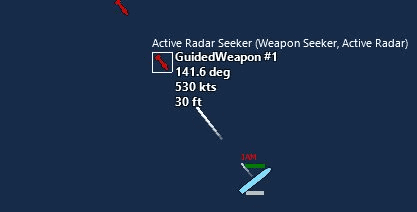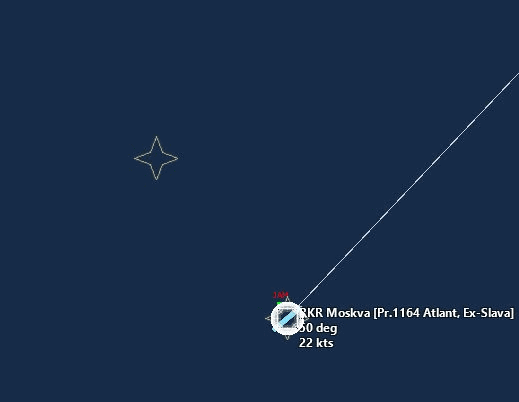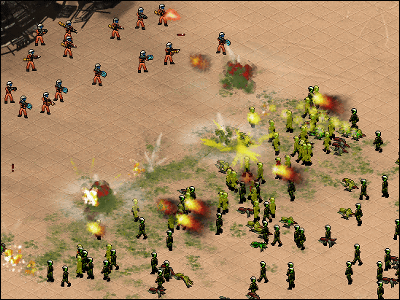This is a simulation of the situation where the Russian cruiser Moskva sank with an anti-ship missile.

On April 14, 2022, the Russian missile cruiser '
Simulating the Sinking of the Moskva --Weapons Release
https://weaponsrelease.com/2022/04/18/simulating-the-sinking-of-the-moska/
Moscow, which was the flagship of the Black Sea Fleet in Russia, is a guided missile cruiser that was launched in 1979 and completed in 1982. Most of the sensors installed were from the 1970s to the 1980s, and the VLS (Vertical Launch System) between the bridge and the radar tower was equipped with a ship-to-air missile called the S-300F .

On the other hand, Neptune, which sank Moscow, is an improved version of the 3K60
In the attack on April 14, it was confirmed that smoke was rising from the vicinity of the heavily tilted Moscow bridge. This image points out that two Neptune missiles may have hit near the Moscow bridge.
Initial analysis on the images:
— Granger (@ GrangerE04117) April 18, 2022
In the images of Moskva after the hit. The damage and the active fire seems to originate in the amidships of the ship where the chimney is located and two of the six AK-630s are located.
Some people suggest it is where the two missiles hit it. Pic.twitter.com/xEOMoyhw2M
The image below is a simulation diagram with Weapons Release. The elongated red icon is Moscow, the plane icon to the left is the Ukrainian drone ' Bayraktar TB2 ', the land icon on the upper left is the Neptune launcher, and the red circle is the Neptune range. The Weapons Release has placed Moscow at the very limit of Neptune's range.

In the figure below, the light blue elongated icon in the center of the circle is Moscow. The yellow circle is the range of the carrier-based sensor. The light blue circle is within the range where the radar can detect the target, and the radius is about 18 nautical miles (about 33.3 km). And the red icon on the upper left is Neptune.

Assuming that Moscow's basic capabilities are fully demonstrated, the S-300F will be launched from Moscow when Neptune is in the detection range. In addition, 'VAMPIRE' displayed on Neptune is a communication code indicating an attack by an anti-ship missile.

The first Neptune will be intercepted 12 nautical miles (about 22 km) from Moscow, and the second will be intercepted 5 nautical miles (about 9 km). Even if Neptune explodes due to interception, it can be said that it is almost impossible for Moscow to be damaged by debris or impact.

However, Weapons Release is actually 'target detection' by an

So, if the OODA loop takes twice as long as expected, '30 seconds to detect, 16 seconds to capture the target, 4 seconds to enter interception', the second Neptune is 4 nautical miles (about 7.4 km). It is said that it will be shot down within.
Also, if you set '60 seconds to detect, 32 seconds to capture the target, 8 seconds to intercept', both of the two Neptunes will reach within 3 nautical miles (about 5.6 km). However, in reality, radar and sensors are used for detection, and it is almost impossible for Moscow in battle to avoid missiles, so the problem this time is 'the time from detecting the target to capturing it'. Weapons Release states.
And if you double the time of the OODA loop, both Neptune hits Moscow. Moscow damaged 43.6%, especially around the radar. From this result, the Weapons Release points out that Moscow may have taken more than 64 seconds to capture the target.

The Weapons Release also notes that Moscow was unable to detect the Bayraktar TB2, which was flying 20 nautical miles (about 37 km), assuming that Moscow had its radar disabled or unusable. doing. In addition, the 3D radar MR-710 '
'Since the first ship, Moscow, and the second ship, Martial Ustinov, are MR-710' Fregat M ', they do not have the ability to detect low-altitude targets. .. .. -Blaze -Io-Mr. Kaefu's missile cruiser Moscow's low-altitude target detection capability story --- Togetter
https://togetter.com/li/1873918
If Moscow couldn't use radar and relied on radio interception ...

The S-300F is finally launched from Moscow after receiving the target signal from Neptune. At this time, the distance between the first Neptune and Moscow is only 1800 meters.

Although the first shot of Neptune can be shot down with this S-300F, the second shot that comes after that is said to have resulted in avoiding the S-300F and hitting Moscow.

Similarly, if Moscow cannot use the radar and it takes 10 seconds more to capture the target, Neptune can reach Moscow up to 3 nautical miles unnoticed. In this case, the interception of Moscow was not in time, and it seems that both shots hit Moscow.
'The simulations showed that Moscow's survival rate seemed to increase significantly, even with minimally disabling radar and sensors, or even changing the time it takes for the OODA loop,' said Weapons Release.
Related Posts:







